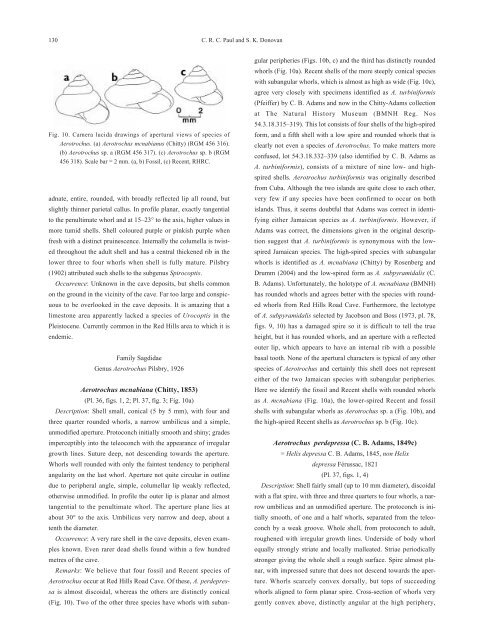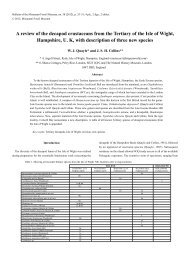Quaternary and Recent land snails (Mollusca: Gastropoda) from ...
Quaternary and Recent land snails (Mollusca: Gastropoda) from ...
Quaternary and Recent land snails (Mollusca: Gastropoda) from ...
Create successful ePaper yourself
Turn your PDF publications into a flip-book with our unique Google optimized e-Paper software.
130<br />
Fig. 10. Camera lucida drawings of apertural views of species of<br />
Aerotrochus. (a) Aerotrochus mcnabianus (Chitty) (RGM 456 316).<br />
(b) Aerotrochus sp. a (RGM 456 317). (c) Aerotrochus sp. b (RGM<br />
456 318). Scale bar = 2 mm. (a, b) Fossil, (c) <strong>Recent</strong>, RHRC.<br />
adnate, entire, rounded, with broadly reflected lip all round, but<br />
slightly thinner parietal callus. In profile planar, exactly tangential<br />
to the penultimate whorl <strong>and</strong> at 15–23° to the axis, higher values in<br />
more tumid shells. Shell coloured purple or pinkish purple when<br />
fresh with a distinct pruinescence. Internally the columella is twisted<br />
throughout the adult shell <strong>and</strong> has a central thickened rib in the<br />
lower three to four whorls when shell is fully mature. Pilsbry<br />
(1902) attributed such shells to the subgenus Spirocoptis.<br />
Occurrence: Unknown in the cave deposits, but shells common<br />
on the ground in the vicinity of the cave. Far too large <strong>and</strong> conspicuous<br />
to be overlooked in the cave deposits. It is amazing that a<br />
limestone area apparently lacked a species of Urocoptis in the<br />
Pleistocene. Currently common in the Red Hills area to which it is<br />
endemic.<br />
Family Sagdidae<br />
Genus Aerotrochus Pilsbry, 1926<br />
Aerotrochus mcnabiana (Chitty, 1853)<br />
(Pl. 36, figs. 1, 2; Pl. 37, fig. 3; Fig. 10a)<br />
Description: Shell small, conical (5 by 5 mm), with four <strong>and</strong><br />
three quarter rounded whorls, a narrow umbilicus <strong>and</strong> a simple,<br />
unmodified aperture. Protoconch initially smooth <strong>and</strong> shiny; grades<br />
imperceptibly into the teleoconch with the appearance of irregular<br />
growth lines. Suture deep, not descending towards the aperture.<br />
Whorls well rounded with only the faintest tendency to peripheral<br />
angularity on the last whorl. Aperture not quite circular in outline<br />
due to peripheral angle, simple, columellar lip weakly reflected,<br />
otherwise unmodified. In profile the outer lip is planar <strong>and</strong> almost<br />
tangential to the penultimate whorl. The aperture plane lies at<br />
about 30° to the axis. Umbilicus very narrow <strong>and</strong> deep, about a<br />
tenth the diameter.<br />
Occurrence: A very rare shell in the cave deposits, eleven examples<br />
known. Even rarer dead shells found within a few hundred<br />
metres of the cave.<br />
Remarks: We believe that four fossil <strong>and</strong> <strong>Recent</strong> species of<br />
Aerotrochus occur at Red Hills Road Cave. Of these, A. perdepressa<br />
is almost discoidal, whereas the others are distinctly conical<br />
(Fig. 10). Two of the other three species have whorls with suban-<br />
C. R. C. Paul <strong>and</strong> S. K. Donovan<br />
gular peripheries (Figs. 10b, c) <strong>and</strong> the third has distinctly rounded<br />
whorls (Fig. 10a). <strong>Recent</strong> shells of the more steeply conical species<br />
with subangular whorls, which is almost as high as wide (Fig. 10c),<br />
agree very closely with specimens identified as A. turbiniformis<br />
(Pfeiffer) by C. B. Adams <strong>and</strong> now in the Chitty-Adams collection<br />
at The Natural History Museum (BMNH Reg. Nos<br />
54.3.18.315–319). This lot consists of four shells of the high-spired<br />
form, <strong>and</strong> a fifth shell with a low spire <strong>and</strong> rounded whorls that is<br />
clearly not even a species of Aerotrochus. To make matters more<br />
confused, lot 54.3.18.332–339 (also identified by C. B. Adams as<br />
A. turbiniformis), consists of a mixture of nine low- <strong>and</strong> highspired<br />
shells. Aerotrochus turbiniformis was originally described<br />
<strong>from</strong> Cuba. Although the two isl<strong>and</strong>s are quite close to each other,<br />
very few if any species have been confirmed to occur on both<br />
isl<strong>and</strong>s. Thus, it seems doubtful that Adams was correct in identifying<br />
either Jamaican species as A. turbiniformis. However, if<br />
Adams was correct, the dimensions given in the original description<br />
suggest that A. turbiniformis is synonymous with the lowspired<br />
Jamaican species. The high-spired species with subangular<br />
whorls is identified as A. mcnabiana (Chitty) by Rosenberg <strong>and</strong><br />
Drumm (2004) <strong>and</strong> the low-spired form as A. subpyramidalis (C.<br />
B. Adams). Unfortunately, the holotype of A. mcnabiana (BMNH)<br />
has rounded whorls <strong>and</strong> agrees better with the species with rounded<br />
whorls <strong>from</strong> Red Hills Road Cave. Furthermore, the lectotype<br />
of A. subpyramidalis selected by Jacobson <strong>and</strong> Boss (1973, pl. 78,<br />
figs. 9, 10) has a damaged spire so it is difficult to tell the true<br />
height, but it has rounded whorls, <strong>and</strong> an aperture with a reflected<br />
outer lip, which appears to have an internal rib with a possible<br />
basal tooth. None of the apertural characters is typical of any other<br />
species of Aerotrochus <strong>and</strong> certainly this shell does not represent<br />
either of the two Jamaican species with subangular peripheries.<br />
Here we identify the fossil <strong>and</strong> <strong>Recent</strong> shells with rounded whorls<br />
as A. mcnabiana (Fig. 10a), the lower-spired <strong>Recent</strong> <strong>and</strong> fossil<br />
shells with subangular whorls as Aerotrochus sp. a (Fig. 10b), <strong>and</strong><br />
the high-spired <strong>Recent</strong> shells as Aerotrochus sp. b (Fig. 10c).<br />
Aerotrochus perdepressa (C. B. Adams, 1849c)<br />
= Helix depressa C. B. Adams, 1845, non Helix<br />
depressa Férussac, 1821<br />
(Pl. 37, figs. 1, 4)<br />
Description: Shell fairly small (up to 10 mm diameter), discoidal<br />
with a flat spire, with three <strong>and</strong> three quarters to four whorls, a narrow<br />
umbilicus <strong>and</strong> an unmodified aperture. The protoconch is initially<br />
smooth, of one <strong>and</strong> a half whorls, separated <strong>from</strong> the teleoconch<br />
by a weak groove. Whole shell, <strong>from</strong> protoconch to adult,<br />
roughened with irregular growth lines. Underside of body whorl<br />
equally strongly striate <strong>and</strong> locally malleated. Striae periodically<br />
stronger giving the whole shell a rough surface. Spire almost planar,<br />
with impressed suture that does not descend towards the aperture.<br />
Whorls scarcely convex dorsally, but tops of succeeding<br />
whorls aligned to form planar spire. Cross-section of whorls very<br />
gently convex above, distinctly angular at the high periphery,





